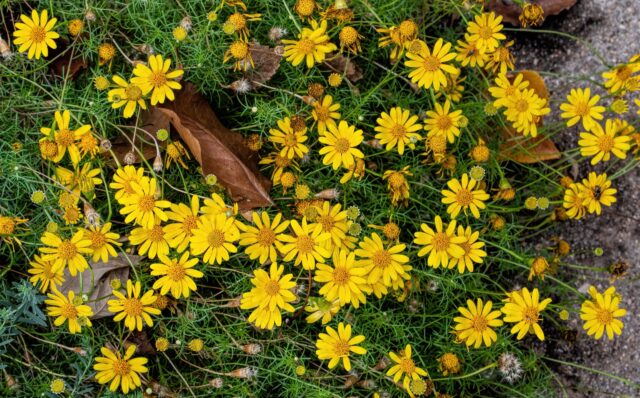
Butterflies are plentiful right now. Here are some I spotted in gardens and fields around town.
Trivia that matter
Some new neighbors have moved in the next street over.
***
Most of the plants I started this year are perennials which will take a year or two to reach blooming size. However, a number have flowered already. Currently, Helianthus mollis, the “ashy sunflower,” is putting on a good show. The plant has a more refined appearance than most sunflowers. According to what I’ve read it’s inclined to be rambunctious, so I’ve got it in the dry far corner of the yard where its aggressiveness will be a virtue.

Spring was unusually dry, but June rains have made up for it. The garden overall is doing well. Nearly all the foxgloves are blooming or will be soon. These are “Camelot mix” hybrids I started indoors earlier. So far all the flowers have been lavender, but there should eventually be a few other colors.
My parish church, a few days after Easter; best viewed in full-screen mode. There are notes on the church here. The architect was Emanuel L. Masqueray, who also designed the cathedral in Wichita.
Here’s the exterior:
While out and about with my camera Saturday, I came across the annual “Downtown Mayhem Biker Bash,” sponsored by a used motorcycle dealer. I don’t think I’ve ever seen so much chrome in one place.
I discovered that the local community college has a well-maintained garden which includes a good selection of prairie plants and others adapted to Kansas extremes.2
Let’s see….
The local used motorcycle dealer established a “2 Wheeler Park” across the street from his shop, featuring grass, daylilies, roses, and a few motorcycles that are a bit past their prime.
Linum perenne puts on a good show when the neighborhood cats haven’t flattened it.
Another of the orchids I got last year is blooming. This one is a hybrid of Australian Dendrobium species, probably mostly D. kingianum. Specifically, it’s SVO9679: “Den. Purple Zip ‘SVO’ x Den. King Zip ‘Red Splash,'” from Sunset Valley Orchids. The flowers are an inch and a quarter across, much smaller than the very red Cattleya’s. In compensation, there are a lot more of them, and they have a fine spicy fragrance.
Incidentally, this orchid has nothing to do with the “Dendrobium” in a certain game featuring cute girls and bad botany. It’s not a “Lycoris,” either.

The temperature today got up to 88°. In about twelve hours it will be down to around 30°; it’s springtime in Kansas. It will be cold again Thursday morning, but after that it should be safe to plant this year’s batch of seedlings outside. As usual, I was over-ambitious and will have plenty to give away should anyone reading this be in the central Kansas area soon. I concentrated on drought-tolerant perennials this year. Once they’re established, most will need little care, though they all will need regular watering during their first summer. A few will bloom this year, but most will require patience.
Pictured above: Digitalis, Symphyotrichum (i.e., Aster), Dalea, Oenothera, Thermopsis, Achillea, Dianthus, Ptilotus, Callirhoe, Salvia, Lupinus, Monarda, Delosperma, Penstemon (three kinds), Rudbeckia, Helianthus, Silphium, Baptisia, Asclepias, and Liatris. (Not pictured: Talinum (or Phemeranthus), Amorpha.) The majority are from Prairie Moon Nursery.
Right now is peak bloom for bradford pears. I don’t have any in my yard, but my neighbors do. This is from my driveway:

We have a few days of spring here, though winter will return within a week. Outdoors, iris and daffodils are getting started. Indoors, the first batch of seeds are up.
*****
I recently came across a curious website, SC Garden Guru, featuring a vast number of articles on botanical topics by one “Bonnie.” This discussion of Lupinus perennis is a typical entry. Notice anything odd about it? What might you suspect about Bonnie?

Here are a few snapshots from the yard taken this week. The low tonight will be 25°F, according to the weatherman. It’s possible that some of the plants will survive that, thanks to the microclimate near the house. However, the 20° forecast for Friday night will probably do them all in. These are likely the last garden pictures of the year (though indoors the very red orchid has a fresh set of buds).
Each of the very red Cattleya flowers lasted a full four weeks. Even after they finally fell off the plant, they retained their form and pigments. They look particularly colorful when illuminated from the back.
The freakish freezes earlier this week wiped out most of the morning glories before they bloomed. Not all, though: those growing on the fence under a mulberry tree survived. Apparently the canopy of leaves conserved enough heat that the vines were able to weather the 24°F temperature. Those particular plants were lagging behind the others, though, and they still might not bloom before the next hard freeze.
The afternoon before the first freeze I cut the flowering stem that was furthest along and put it in water inside the house. Today the first and probably last flower opened; my efforts were not completely in vain. Much as I like the color blue, though, I probably will grow something else next year.
(The Burpee seed packet states “75 days to bloom.” Nope.)